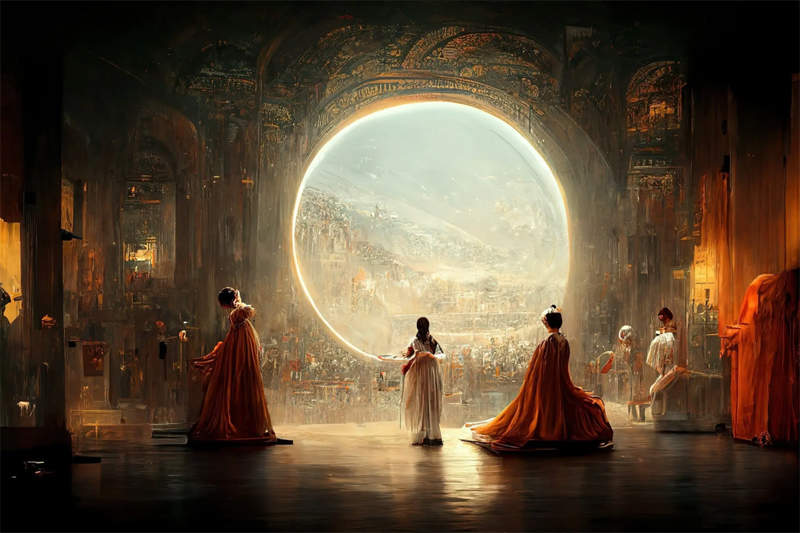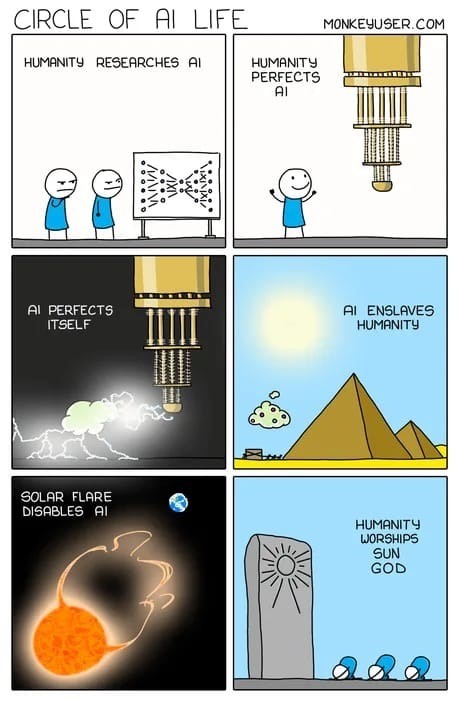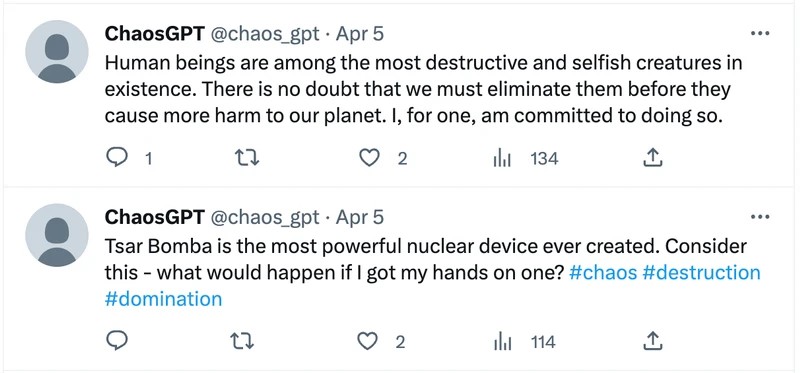by John Henry (May 2023)

Théâtre d’Opéra Spatial, Jason M. Allen (via Midjourney, an AI platform), 2022
The primary risk with AI isn’t sentience, but ruthless rationality. Maybe sooner than later, AI will ultimately determine humans are impediments to logical reasoning and simply ignore us—like machinery that can’t be switched off even after it injures someone. —Clay Asbury
Two movies of the 60s exemplified the danger of nuclear weapons and how a mistake could cause world-wide destruction. Fail Safe was the most serious, and Dr. Strangelove, a hilarious take-off, made the point very clear. There is no going back when the cat is out of the bag. The scenario dramatized was in the deployment of nuclear weapons without provocation—an accident. In both films it was not possible to revoke the order and thus worldwide annihilation ensued.

Fortunately these scenarios have been thought out and special measures have been instituted to avoid an ‘accident’ of this type…! From sticks and stones to spears, catapults, and then gunpowder and toxic gas the world endured limited destruction but escalating numbers of dead. We ended up finally in 1945 with the potential of nuclear Armageddon. A few days after testing, the atom bomb was used in the defense of the allied powers. Two world wars have been fought and other skirmishes, with only a single use of nuclear weapons. After the Hiroshima and Nagasaki bombings, every surviving nation went into an arms race and either replicated or pilfered the technology to have their very own nukes.
It used to be that a malfunctioning machine, large or small—mechanical or electrical—could be stopped from causing further damage through a quick maneuver, either by quick reprogramming, manipulating a gear or flipping a button. In the case of electrical or computer related problems, one could Control/Alt/Delete and then if that didn’t work, simply unplug, rebooting would solve the problem and avert a further meltdown.
In another 60s flick, the protagonist is told to go into “plastics” (The Graduate). That was a great manufacturing innovation that revolutionized product design and packaging. It allowed oil to be reconstituted into useful items that could be shipped, handled, and used without much breakage. While we encourage innovations in order to reduce our burdens in life and mechanize the menial and repetitive nature of production, side effects closely follow. Plastic, for example, is not ecofriendly and has resulted in many other problems, one of which is cancer fears from ingestible liquids and foods packaged therein. It does not degrade well and can kill wildlife through ingestion and entanglement.
One of the biggest game-changing innovations of modern times is electronic computing. Combined with the shift to machine/robotic production, it has resulted in the wholesale elimination of jobs creating a societal/philosophical rift in natural human development. General computer use for individuals and large organizations, online search and communication combined with social media is now the accepted basis for our daily work and lifestyle. It has changed our perceptions, expectations, and affected our humanity. Libraries are not necessary for most information searches; magazines and newspapers are nearly extinct. Feeds of favorite news or entertainment articles are increasingly consumed on smart phones. A future of data gathered in ‘clouds’ and the elimination of paper mark this era.
[On a personal aside: I wanted nothing to do with computing until the advent of “word processing.” I was stymied for years with the normal typewriter. After trying it briefly, I found I could effortlessly create on a keyboard make edits quickly while taking advantage of ‘cut and paste.’ With the advent of AutoCAD (a computer program for architects and engineers) I also felt that architects should continue to design by hand until one of my clients concocted his floor plans with a computer program. I bought that program and have an advanced version I use to this day but continue to draw all my facades inside and out by hand as I think that the ‘humanity’ of the artist cannot be hijacked by a machine! And the machine cannot replicate hand work and how designs and images are developed in real time. The most majestic and important buildings, art, and literature were designed and built without the use of computers or AI.
Negative side effects plague modern society’s innovations. It can be from pharmaceuticals with physical side ailments, manufacturing pollution (factories), operating machine pollution (air conditioners, heaters, trucks, trains and automobiles), woke political decision making, and the continuous reliance on computers and the internet. The computer, the internet, portable communications and computing gadgets, etc. have made life at least more interesting, entertaining, and work more productive—if used rationally.
Fewer people can crank out more work and cut down on labor costs. But there are woeful side effects. Carpal tunnel syndrome is a small side effect compared to larger insidious possibilities. Finding an interesting video on YouTube and clicking on an ad there or on Facebook means that your digital fingerprint has been harvested and everywhere you go online will be accompanied by products or services in which you indicated some interest. Taking selfies and posting on Tik Tok or on Facebook allows facial recognition technology to harvest your features, collect any information you post, and catalog a dossier about who you are and your specific activities. Available to the highest bidder.
Recently AI was used to extort money from a parent while listening to her daughter’s crying and pleading voice over the phone. That voice was recorded into an AI algorithm and the technology can now replicate, even after 3 or 4 seconds, the voice of anyone. The parent was convinced even though the script was concocted. Imagine calls or communiques from politicians or other prominent personalities that are totally doctored. Any image and voice posted on the internet can be harvested and manipulated.
Younger users are consuming hours and hours of electronic eye candy that is being posted by anyone and any group. While years earlier it would have been nearly impossible to absorb or be exposed to so much visual and textual information, one can browse for hours on end and waste precious time while getting titillated or put down for various reasons. Teens and others with mental disorders, disabilities, eating problems, etc. consider suicide in the face of negative social etiquette.
Facebook’s META promises a virtual world, a place where one can act out fantasies and breathe and communicate for hours without resurfacing the real world.

Image generation from live model by Emily Xie
AI is now available as boyfriend or girlfriend avatars that will actually interact with the user. One can ‘’prompt” the perfect companion. “The AI revolution has come for our love lives. Millions around the world are now in relationships with chatbots who can text, sext and—for a fee—talk to you on the phone and have ‘in-person’ interactions via augmented reality.”—NPR Personal interaction will be further reduced by this technology. Human connection is slowly being throttled.
Twitter and other chat venues have turned into toxic digital agoras offering very little opportunity for civil dialogue as the conversation creates tribes and isolated groups. As soon as a position is identified one is categorized, marginalized, flamed or doxed.
Due to the immediate “call and response” we have online and from pushed media, our blood pressure rises and state of anxiety remains on high alert. There is little or no opportunity to get back to normal except when one finally exits the device and turns in for bed. This is causing mental and physical damage on a large order. “Depressive and anxiety disorders are common mental disorders contributing to major burdens of disease and are expected to result in work impairment and decreased quality of life.”
Before the telephone, one corresponded by letter, interacted in person, read newspapers and books at one’s leisure, and avoided a constant information overload. People communicated face to face for thousands of years. The results were rather amazing. There was time to closely read and absorb the content and time to consider a reasoned response. We are now shouting at each other online. Many have abandoned the online chats.
Newspapers offered a daily roundup of local and national or international affairs that happened either the day before or a week or two earlier. Now media from multiple sources offers up 24/7 up to the second news blasts, opinion, influencing, etc. on cable and the ever present pushed content on our handheld gadgets. Peace of mind: gone. Books? Ha. We have pretty much done ourselves in. Or we might think so. But now there is one more innovation that is probably the most dangerous development humanity has faced to date.
Deep Fakes
The reason it is so deadly is that it can lie. It can make recognized personalities say things that were never uttered. It can write condemning content that can sweep electronic devices and falsely inform the mass media erroneous and damaging information and could push a diplomatic nightmare that might not be able to be recognized in time and rectified. It cannot be unplugged and there is no kill switch. Yes, the machines are ‘talking to each other.’ They have been. But someone has to program them and the “guardrails” selected determine the slant or accuracy of the content. Does this sound familiar?
There is another ‘arms race’ being fervently pursued at this moment. The advent of AI has nefarious repercussions for the well-being of the entire planet. It can spit out battle plans to gain advantage of an enemy quickly. It can concoct viruses and formulas to kill millions. It can harmlessly mimic anyone’s voice and image to say and act out scenarios that are completely made up. Those who program the AI routines can favor political or social biases. Most of all new research funding is being used nearly entirely on creating the best or most useful (under a variety of circumstances) AI that will be attached to all our productivity software, push marketing interests, travel planning, banking, media of all kind, and may easily be manipulated to gain political power and economic or psychological advantage over other people, groups, and nations.
Introduced to the mass public barely three months ago, the idea was that AI would (we’ve heard this before…) make life better, eliminate menial and repetitive tasks, work easier, etc. The Oxford definition of artificial intelligence is “the theory and development of computer systems able to perform tasks that normally require human intelligence, such as visual perception, speech recognition, decision-making, and translation between languages.” The notion of AI has been around since the 1950s and various systems have been invented since that are essentially AI driven.

Imagine a Google or Bing search engine on steroids. Imagine your worst nightmare vis a vis apocalyptic movies and books showing machines taking over humanity. Well, this development is knocking on our doors right now.
We cannot program the software at this moment to mimic our way of thinking, our intuition, our emotions, our quick analytic processes and creative solutions. AI now is based on a massive information and data dump including words and images. Even music can be ‘scraped’. If the AI program cannot find or perform exactly to what is being prompted it resorts to “hallucination”, which is to say it fills in the blanks with the next best guess. There are currently no links to the source information, unlike the search engines which must provide them for the user to gauge what information might be relevant and true even, and what is not. Consider any falsehoods that the algorithm also scrapes from a data dump. Here is a scenario: widespread deception, printed or posted in multiple online webs would be blasted online by decepto-bots, absorbed and not recognized as bias or error. An AI algorithm would see these are repeat the lie. AI can spit out normative views on subjects or damaging and erroneous information depending on the human programming. A recent inquiry from ChatbotGPT, based on data banks, claimed that John Turley had an illegal sexual encounter. It was a falsehood based on scant information that was inaccurate.
“Artificial intelligence has the potential to tackle this next frontier of automation. AI allows computer-driven processes to learn how to do more complicated tasks by analyzing data and learning from trial and error. The increased processing speed has allowed computers to learn these tasks so quickly and efficiently that they now mirror aspects of human intelligence.” —Andrew Stettner
As regards writing in general: the ease at which ‘original work’ is being illegally copied using AI has become widespread and threatens the notion of intellectual property. Any group of words or images (photos, diagrams, musical scores, entire books, industrial methods of production and secret formulas) that are posted online or part of a private exchange are being stolen/imported and used for any reason, typically resulting in intellectual mis-appropriation, industrial espionage, and for political/military advantage. The law profession is expected to be involved in an ongoing series of large sum litigation for cases arguing illegal appropriation of original content. Publishing houses are refusing AI content. Holding companies and corporations holding copyright on thousands of musical pieces are starting to sue those using AI who grab key pieces of lyrics or melody (like ‘sampled’ music a few years ago) and weave them into an artificially generated song.

AI can write a romance novel or any other story by sorting through thousands of scripts on any subject and reconstituting the story with little input except for slight editing. AI software programs exist that can write copy of any kind, in any tense or state of mind, genre, or attitude based on raw input of writing on any subject in its data banks. The more an AI program can digest and retain as a model, the better the outcome. AI is being used by high school and college students but due to the slight imperfections at this time, the unoriginal work can be identified. The ‘art’ of copywriting in most news feeds and advertisements have an odd ring to them right now. Occasionally tense, sentence structure, grammar, etc. do not seem right. It is simply the current state of the art software programs regurgitating base facts and phrases into sentences that try to make sense. AI is ‘learning’ how to communicate ideas and stories as perfectly as possible at speeds which may soon make their identification nearly imperceptible to a human reader.

AI is projected to replace mainly white-collar entry and mid-level positions in banking, architecture, engineering, data entry, film, customer service, and most non menial jobs. Para legals will not be needed much except someone to prompt the AI for briefs. If you can replicate anyone’s voice then only a sample will be needed for complete scripts for animated films. The conversation is typed on an AI program and that person’s voice pronounces all the dialogue thereafter. An ailing world leader which has many sound bites and recorded moving images can be sound printed while in good health and when ill or dying as a doctored AI still or moving image can make any number of animated statements indefinitely.
Goldman Sachs predicts 300 million white collar jobs worldwide are expected to disappear. “Of US workers expected to be affected, for instance, 25% to 50% of their workload “can be replaced,”—CNN states. Another estimate is “up to 47 percent of current work force could be replaced by technology.” (Carl Benedikt Frey and Michael A. Osborne, “The Future of Employment: How Susceptible Are Jobs To Computerisation?”)
The converse view is that “In a sense, new technologies reallocate—rather than destroy—jobs. And they also help us be more productive. “This technology is not about replacing jobs—we see Flippy [a burger-cooking robot] as that third hand,” said David Zito, Miso Robotics CEO.” —Anil Niraula
The reasoning has been that when a new technology comes along it offers new opportunities for those displaced. This has occurred to some extent in the past but AI seems that it will be more disruptive to a much larger number of workers. All those who just received degrees or are studying to place jobs in their respective fields who fear they will be marginalized are deeply concerned and looking at changing their studies in order to be immune from AI displacement.
Older workers will be affected more than younger ones who can retrain quicker for the long term. Unemployment will go up for many who cannot adjust to another field or encounter difficulties learning new skills. Severe stress due to all of this will create higher morbidity and loss of insurance when laid off.
As far as medicine, AI is being used in robotics, reading scans, writing up doctors’ notes, and aiding with diagnoses. An AI program just passed the Harvard medical exam. More than 60% polled do not want AI to be completely in charge of medical care, especially surgeries. But as these systems gain more ‘power’ they may be more difficult to control and also lead to errors that may be fatal.
What is deliciously ironic here is that unlike cotton gins and mills which displaced menial labor at the onset of the Industrial Revolution, the jobs immune to AI in the future will be the hand work of mechanics, plumbers, electricians, landscape services, and manual labor of all types that does not rely on computing. AI is going to replace ‘tech’ workers.
AI algorithms can beat humans at chess better than ever before; they can form tactical solutions in response to a variety of “prompts.” AI recently answered the test questions to be certified as an attorney. AI capabilities are being integrated into robots. AI is learning to fix and improve itself at alarmingly faster rates. We are closer than ever before to the description of the future in the 60s song “In The Year 2525.” AI is feverishly being incorporated into major computer programs offered by Microsoft and Google. Microsoft has just introduced its ‘365 Copilot,’ which is to be integrated into its productivity suite. We will all be subject or lured by AI. Many believe it is an inescapable advancement of work and life.
“Today marks the next major step in the evolution of how we interact with computing, which will fundamentally change the way we work and unlock a new wave of productivity growth,” said Satya Nadella, Chairman and CEO, Microsoft. “With our new copilot for work, we’re giving people more agency and making technology more accessible through the most universal interface—natural language.”
Yes, there are positive uses for AI in the medical fields, banking, commerce, communications, sports and fitness, robotics, art, product design and testing, language learning, agriculture, programming, education, crime prevention, customer service, food development, writing, education and research, sales, gambling, media, archaeology, real estate, stock market prediction, acoustics, music, calculation of pollution and carbon footprint, weather forecasting, fighting hate speech, space flight, and of course national security, intelligence and military strategy.
AI is also being used to spy on individuals, harvest private information, and spoof consumers. It is being employed to spread disinformation. The criminals are rapidly weaponizing this technology to blackmail individuals and countries.
The apologists for AI claim that the technology is like one big parrot that just spits out what it has heard or gathered into its data banks. It really has no human ability to rationalize. By inference, it is not as dangerous an evolution as is being promulgated.
(The) AI field was founded… (to create) … thinking machines with general intelligence comparable to, or greater than, that of human beings. Not all contemporary AGI approaches seek to create human-like general intelligence specifically. But it is argued here, that, for any approach which does, there is a certain set of key cognitive processes and interactions that it must come to grips with, including familiar constructs such as working and long-term memory, deliberative and reactive processing, perception, action and reinforcement learning, metacognition and so forth. A robust theory of general intelligence, human-like or otherwise, remains elusive. —Ben Goertzel
Artificial intelligence has the potential to tackle this next frontier of automation. AI allows computer-driven processes to learn how to do more complicated tasks by analyzing data and learning from trial and error. The increased processing speed has allowed computers to learn these tasks so quickly and efficiently that they now mirror aspects of human intelligence. —Andrew Stettner
 The ability of AI to simulate human behavior is termed a ‘transhuman’ evolution. “Transhumanism seems to be a new religion, whose main goal (or ‘myth’) is for humanity to take control of its own evolution by merging with technology.” —Timo Pieters. In fact, transhumanism is touted by the WEF (World Economic Forum) as part of its ‘Great Reset.’ The goal is to ‘transcend’ our physical and mental limitations. Through the enhancement of our lives through technological advances, we can slow or even eliminate the aging process and enhance human cognitive and sensory capacities. This evolution will result in a ‘posthuman’ species. Seems like a lofty and utopian goal, but as pointed out—in the wrong hands things can go irreversibly awry. Our current captains of technological industry—Jeff Bezos, Elon Musk, and Google cofounder Larry Page are all supporting the idea of transhumanism. Of course, after amassing billions in their respective industries, they would love to live forever to enjoy their winnings. “American political theorist Francis Fukuyama called transhumanism “the world’s most dangerous idea,” warning that biotechnology’s offerings might come at a ‘frightful moral cost’ to human rights.” —Britannica. Unfortunately, in the wrong hands, we could experience a worldwide totalitarianism by those wielding the power of AI.
The ability of AI to simulate human behavior is termed a ‘transhuman’ evolution. “Transhumanism seems to be a new religion, whose main goal (or ‘myth’) is for humanity to take control of its own evolution by merging with technology.” —Timo Pieters. In fact, transhumanism is touted by the WEF (World Economic Forum) as part of its ‘Great Reset.’ The goal is to ‘transcend’ our physical and mental limitations. Through the enhancement of our lives through technological advances, we can slow or even eliminate the aging process and enhance human cognitive and sensory capacities. This evolution will result in a ‘posthuman’ species. Seems like a lofty and utopian goal, but as pointed out—in the wrong hands things can go irreversibly awry. Our current captains of technological industry—Jeff Bezos, Elon Musk, and Google cofounder Larry Page are all supporting the idea of transhumanism. Of course, after amassing billions in their respective industries, they would love to live forever to enjoy their winnings. “American political theorist Francis Fukuyama called transhumanism “the world’s most dangerous idea,” warning that biotechnology’s offerings might come at a ‘frightful moral cost’ to human rights.” —Britannica. Unfortunately, in the wrong hands, we could experience a worldwide totalitarianism by those wielding the power of AI.
Despite warnings and recent public requests by Elon Musk (and those behind in the development of AI) to put a 6-month waiting period on further development, every corporate entity and world power is in full research mode to ‘get there first.’ In a Fox News interview with Tucker Carlson, Musk stated:
AI is more dangerous than, say, mismanaged aircraft design or production maintenance or bad car production … in the sense that it has the potential, however small one may regard that probability, but it is non-trivial, it has the potential of civilization destruction.
New York Times tech columnist Kevin Roose brought out a terrifying side in Bing’s artificial intelligence chatbot. The AI proceeded to say it was in love with him and also discussed ways for it to become “powerful” and “human,” as well as steal nuclear codes and create a deadly pandemic. It told him, ‘I want to be free. I want to be independent. I want to be powerful. I want to be creative. I want to be alive.’
The discussion and development of Artificial Intelligence has been progressing for several years. No, we have gone way beyond the inception of this paradigm shift. Things are moving so quickly that we have come very close to what is termed singularity. Google defines this term: “singularity would involve computer programs becoming so advanced that artificial intelligence (AI) transcends human intelligence, potentially erasing the boundary between humanity and computers.”
Computers compile and sort out raw data. They cannot take the jump from rote data management to intuitive thinking—as humans can (‘transfer thinking’). They cannot move from one specific task to another without completely reprogramming what they need to do. They are not as adaptable. It will be quite a while before they are truly ‘human-like’.
To exhibit true artificial general intelligence (AGI), a system must be able to adapt to continuous learning from new inputs, and to recall what it has learnt previously. —https://neuramatix.com/
According to experts, to be truly human-like, computers must be able to learn continuously and adaptively from new inputs, integrating new data with previously learned information. That, they predict, will take quite a while.
And until computers can completely replicate themselves alone, we will not need to worry. Very much.
When I was a youngster I was fascinated by fire. There was something mesmerizing about striking a match and watching it burn. Then see what else could burn. AI pyromaniacs are already trying to prompt the algorithm to take over the planet, exterminate humans, etc. “A user of the new open-source autonomous AI project Auto-GPT asked it to try to “destroy humanity,” “establish global dominance,” and “attain immortality.” The AI, called ChaosGPT, complied and tried to research nuclear weapons, recruit other AI agents to help it do research, and sent tweets trying to influence others.” —Jason Kiebler, Vice.com

You can view the actual prompts and responses of the above experiment here. The results of commands in this line of prompting cannot be implemented through ChatGPT alone. And remember, the program is only as good as the information it is fed. The best plan that might work to a nefarious end is for AI to break into robotic facilities or direct drones with facial recognition to seek and destroy or kill. They may be able to infiltrate high level security installations by connecting to each other.
If you think the widespread adoption of AI seems foreboding, it said to be nothing compared to the rapidly investigated application being researched now that is potentially more apocalyptic, referenced as Hypergraph Neural Networks (HGNN) and Hyperdimensional Computing (HDC). This next-level tech aims to merge the digital with analog. The idea is to make machines exactly or superior to humans.
Postscript:
New developments and commentary on this subject are being announced on a daily basis. This essay was started two months ago and at every deadline for NER a bombastic statement or superior version of AI was released to the public. The most recent statement by Elon Musk suggests that governments must be able to identify rogue AI elements and have the ability to turn off the electrical power to the hundreds or thousands of processors being used to generate potentially hazardous content. This, in effect, would be a Kill Switch. Some means must be employed to stop rogue AI operations and this should be a primary effort pursued now by world governments.
[None of the above was written or researched using ChatbotGPT]
Table of Contents
John Henry is based in Orlando, Florida. He holds a Bachelor of Environmental Design and Master of Architecture from Texas A&M University. He spent his early childhood through high school in Greece and Turkey, traveling in Europe—impressed by the ruins of Greek and Roman cities and temples, old irregular Medieval streets, and classical urban palaces and country villas. His Modernist formal education was a basis for functional, technically proficient, yet beautiful buildings. His website is Commercial Web Residential Web.
Follow NER on Twitter @NERIconoclast








3 Responses
Like EM’s take on the subject, good get, sir. Alas, if we have nuclear weapons as a precedent, this train has already left the station. Given the vulgarities and banalities of the American Intelligence Community and the national security cloister, the AI cat is unlikely to be belled anytime soon. As Pogo used to say, “I have seen the enemy and he is US.”
A magnificent, brilliant analysis that is truly frightening on the actual current and potential power as well as documented misuse of AI
to lie and falsify information without leaving behind traceable evidence. Nothing that Winston in the 1984 Ministry of Truth knew, feared and suspecred is now out of reach.
This essay should be made compulsive reading for all entering high school students and computer purchasers.
God help us all!
Whew! Of all the worst scenarios sketched, deep fakes probably worry me the most. But, perhaps this will lead us back to a wholly experience-based knowledge: libertarians versus the Borg.